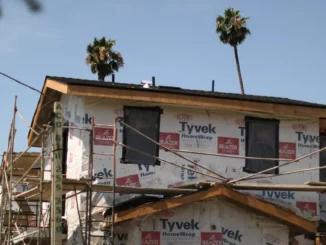
NEW YORK – U.S. real estate stocks are struggling this year after a rough 2022, as fears that banks will tighten lending standards pile pressure on a sector already hit by higher interest rates.
After slumping 28% last year, the S&P 500 real estate sector has gained about 1% in 2023, lagging an 8% rise for the overall S&P 500. Real estate is the only one of the 11 S&P 500 sectors to underperform the benchmark index in both 2022 and so far in 2023.
Driving this year’s struggles are fears that tumult in the banking sector following the collapse of Silicon Valley Bank in March will make it more difficult for real estate companies to access debt, as banks become more stringent on lending. The real estate sector has slumped 2% since SVB’s troubles came to light on March 8, compared to a 4% rise for the S&P 500.
“There is nothing about the current banking situation … that made life easier for real estate companies,” said Peter Tuz, president of Chase Investment Counsel. Because banks have lost deposits, “they will be just more careful who they lend money to,” he said.
With the S&P 500 real estate sector off nearly 30% from its all-time high at the end of 2021, investors are looking to upcoming earnings to determine the sector’s near-term trajectory. S&P 500 real estate company earnings are expected to fall 0.3% this year after rising almost 11% in 2022, according to Refinitiv IBES.
The companies must deliver on their earnings forecasts if they want to reassure investors, said Wes Golladay, an equity analyst at R.W. Baird.
“They just recently provided guidance with their fourth quarter earnings and they have to deliver that,” he said.
Investors are also closely watching office demand, as some of the largest U.S. banks single out commercial real estate as an area of growing concern, partly due to a surge in remote working since the COVID-19 pandemic.
The S&P 1500 office REITs index is down 16% over since March 8 and some individual stocks have seen sharper declines, with shares of SL Green Realty down 26% and Vornado Realty off 19%.
“While the market has clearly priced in a lot of negativity for office REITs, rising delinquency rates and the upward trajectory of vacancy rates implies there could be more downside risk ahead,” wrote LPL Financial’s Adam Turnquist in a note earlier this week.
Another key factor is likely to be the future path of interest rates, investors said. Steady future cash flows from commercial buildings become less attractive as rates rise, and real estate stocks were among the worst hit by the Fed’s aggressive rate increases of 2022.
Valuation for a group of over 130 real estate stocks — comparing stock prices to funds from operations, a common industry metric — fell from 25.5 times earnings at the start of 2022 to 17 times by year end, according to R.W. Baird.
Investors are pricing in another rate increase at the Fed’s monetary policy meeting next month, with rates then starting to fall after the summer. The Fed, on the other hand, has projected rates will remain around current levels for the rest of 2023.
Still, some investors believe the selloff may have created opportunities to buy on the cheap.
Greg Kuhl, portfolio manager on the global property equities team at Janus Henderson, said most publicly traded real estate companies still have sufficient access to capital if they require it, despite last month’s banking issues.
Kuhn’s portfolio is overweight industrial real estate companies, including shares of warehouse company Prologis , an area of the market where he says occupancy rates are comparatively high.
“We think the fundamentals are really strong there,” he said.
Indeed, while vacancy rates have gone up in office space compared to before the coronavirus pandemic hit in 2020, they have fallen over that time in areas such as retail and industrial real estate, according to Glenmede.
The firm currently maintains its weighting in the real estate sector at a level that it has held in previous years, said Michael Reynolds, vice president of investment strategy at Glenmede.
“People have been blindly divesting from REITs because of fears on offices, thinking that what is going on in offices is indicative of the overall space,” Reynolds said. “We tend to think that that’s not the case.”
Source: www.zawya.com
ENB
Sandstone Group



